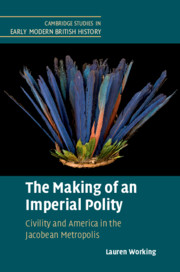On a November evening in 1618, the newly appointed governor of Virginia, George Yeardley, dined with James I at the royal hunting lodge in Newmarket, speaking to the king about his plans to turn Virginia into the English civil society investors had long promised it might become. One of Yeardley’s primary tasks was to inaugurate what has become known as the First General Assembly, held in Jamestown in 1619 in the heart of a region that its Powhatan inhabitants called Tsenacommacah. This article examines the assembly within the context of the Powhatan Chesapeake, examining how English attempts at establishing this meeting, ‘in the nature of a Parliament’, operated within a broader Indigenous political landscape. It considers some of the methodological challenges that historians face when writing about political assemblies in colonised spaces, arguing for the value of approaches that place a greater emphasis on Indigenous sources, knowledge and perspectives. A focus on material culture and archaeological remains, from embroidered deerskins to goffering irons, demonstrates how different claims to authority were tangibly imparted and contested, offering a more expansive archive of seventeenth-century transatlantic political culture.
